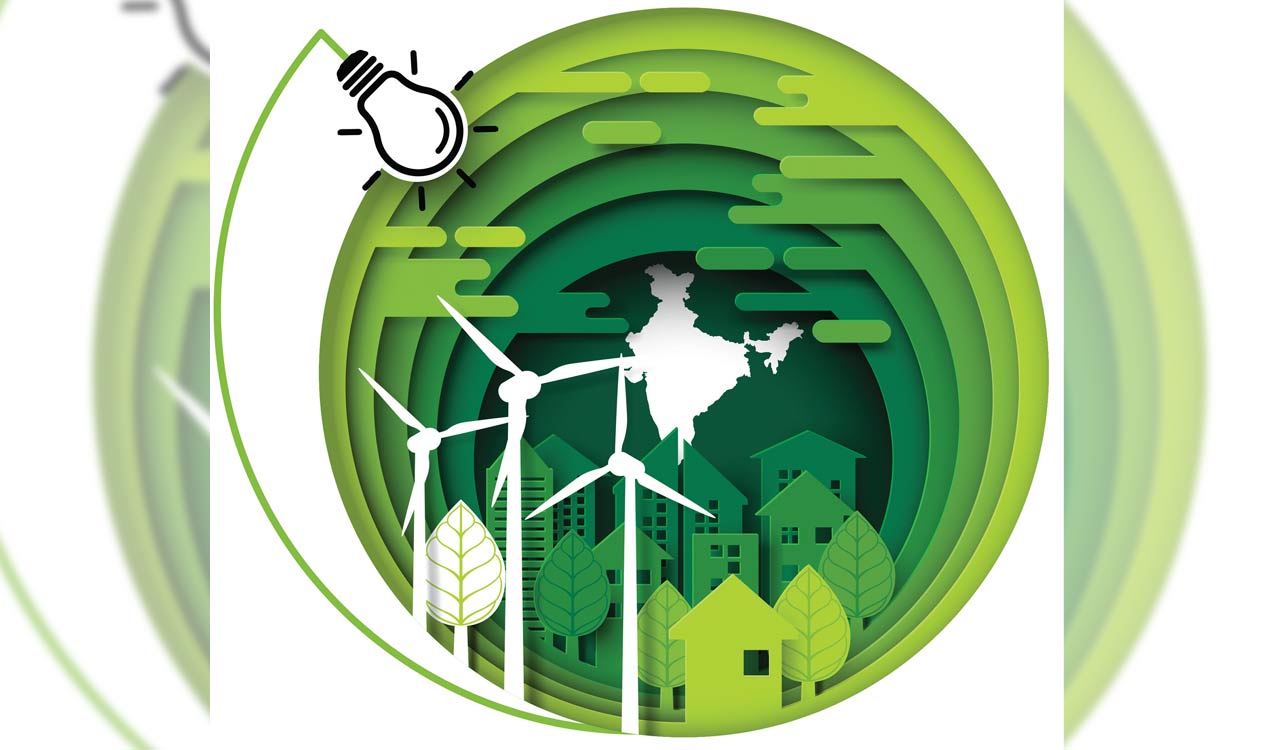
Rewind: New Green Revolution

Gold rush for sustainable energy in India may lead to many fights, but greener greens will be a win-win for all.
Published Date – 12:47 AM Sun – 8 Jan 23

Example: Guruji.
Amit Mishra
Hyderabad: As India As the size of its economy grows, the country’s renewable energy market presents a compelling opportunity for investors. India ranked 3rd in the 2021 Renewable Energy Country Attractive Index (REN21’s Renewables 2022 Global Status Report). Between FY16 and FY22, the industry witnessed remarkable growth with a compound annual growth rate of 16%.
With the world moving towards a more sustainable and eco-friendly future, India is projected to enjoy the fastest growth in renewable energy and quadruple its capacity by 2026. Like the California Gold Rush of the 1850s, the renewable energy space in India is already seeing a rush of entrepreneurs, investors and industrialists eager to capitalize on the growth and potential of the sector.
And as the race to dominate the green energy market heats up, can the country’s most prominent names be far behind? It’s almost as if Mukesh Ambani and Gautam Adani saw the viability of renewable energy years before someone else did, and now they’re at odds with each other to seize the opportunity. Otherwise, who would have imagined that the supposedly commercially lucrative sector of renewable energy would eventually turn a profit?
Reliance Industries, Adani Group, Tata Group and JSW are planning to make a combined investment of around $55 billion over the next 5-10 years. These companies are reportedly in various stages of talks to secure investments for their greenfield solar and wind projects, acquisitions and manufacturing facilities, and are also seeking strategic investments to meet their funding needs.
But why the sudden increase in investment in green energy by the big guys? And why is it that all the corporate honorifics are vying for their place in the nascent arena? Does it promise a return beyond Kane for an ordinary person to understand? let’s find out.
increasing investment
By 2040, the country’s energy consumption is predicted to grow to 16,000 terawatt-hours, and renewable energy will play a key role in determining how to meet this need. Also, the sector is expected to see a total annual investment opportunity of over $30 billion over the next ten years and beyond. This would represent a significant and untapped investment potential that is three times the current level.
India’s share in global primary energy demand is expected to nearly double to around 11% by 2040. The country will need to expand its energy production by 2030, with about half of this increased production coming from renewable sources, to meet and keep up with this increase in demand. Pledged to reduce its carbon footprint by 35% from 2005 levels. According to the Economic Survey (2018-19), this requires installing 25 GW of renewable capacity every year by 2030, which would cost around $250 billion in investment from 2023 to 2030.
In the last eight years, India’s renewable energy sector has attracted investments of over $70 billion Investment, Foreign direct investment (FDI) in this sector has grown steadily over the years, reaching $1.6 billion in 2021-2022 as against $414.25 million in 2013-14. It is also worth noting that FDI in the coal sector in India has been virtually non-existent since 2013-2014, indicating a strong preference for the renewable sector. A total of $64.4 billion was spent on projects and initiatives in this industry between 2014 and 2019, with $11.2 billion coming from one year alone (2019).
private players
The country’s energy sector has traditionally been dependent on fossil fuels. However, due to the increasing scarcity of these resources, there has been a push towards renewable energy, especially since 2020. Private companies, which were earlier dependent on thermal energy, are now playing a leading role in building a green energy portfolio for the country.
private investment in india renewable energy The market grew significantly in 2021 and reached $18.8 billion. Since 2020, there has been a 40% increase in both local and international investments in the sector. A major chunk of this investment has gone into building solar PV systems. It is clear that the need to switch to renewable energy sources is being understood now more than ever.
Suzlon was the first to step into this field in 1995. Slowly and steadily other organizations sprung up, including Azure Power, Orb Energy, Tata Power Renewable Energy and Renew Power. The total market capitalization of all listed renewable companies is pegged at over $40 billion and is expected to triple over the next five years.
The country has come to a point that every major corporate house in India is venturing into green energy as it promises huge returns as India becomes the champion of Net Zero by 2070.
green with envy?
Connecting with where we started, two of India’s most successful business magnates, Mukesh Ambani and Gautam Adani, are set to engage in a grand showdown on the country’s booming renewable energy industry. This marks the first time that their paths will cross in the region. It’s sure to be a battle for the ages, as these industry giants vie for dominance in the sustainable energy sector. Both RIL and the Adani group have made ambitious commitments to clean energy, with Reliance planning to invest around $10 billion in the sector over the next three years and Adani group investing around $70 billion over the next 15-20 years. doing.
Both Reliance Industries and Adani Group are working to set up a value chain for green hydrogen. Reliance announced last year that it would build four giga-factories at the Dhirubhai Ambani Green Energy Giga Complex to produce solar panels, energy storage systems, electrolyzers and fuel cells. Last month, it added plans to build a fifth giga-factory at the same location. Reliance has made several acquisitions as well as stake purchases in the renewable energy sector. Companies include Senshock, a solar energy software manufacturer, Sterling and Wilson Solar, Faradion Ltd., and REC Solar.
The Adani group has also caught up fast. It unveiled plans to add 45 GW of renewable energy generation at its Adani Green Energy unit and aims to produce 3 million tonnes of hydrogen per year by 2030, up from its previous target of 2.5 million tonnes. Adani’s new energy arm, Adani New Energy, also plans to generate 20 GW of renewable energy at its facility in Khavda, Gujarat.
India’s progress in achieving its green energy goals depends on the success of these two billionaires as they shift their businesses towards renewable energy, turning themselves into green energy barons.
But, determining the winner in this race is not important, as it is not a zero-sum game. It is ultimately India that stands to benefit from reaching its goal of net zero emissions by 2070 through the renewable energy wars. The gold rush for sustainable energy in India will continue as billionaires battle it out to capture a piece of this lucrative market. Will this ‘green’ field be a fair game or will it turn into a match of two teams, as the telecom space is playing now? It’s just the early days!
go turns green
• Reliance Industries to invest around $10 billion to set up end-to-end solar power generation facilities by 2024
• Tata Group to raise around $10 billion in next 5 years
• Adani Group commits over $15 billion over next 10 years, aims to become world’s largest renewable energy producer by 2030
• Aditya Birla Group and KP Group signed a $30 million deal in August to set up a wind farm in Gujarat
• Greenco Energy and Hindalco Industries signed an agreement in the same month to build 375-400 MW of solar and wind power capacity, besides setting up a renewable energy project that would provide 100 MW of continuous carbon-free electricity. The venture supports Hindalco’s objective to achieve net carbon neutrality by 2050.
• JSW Energy to invest around $10 billion; JSW Steel $1.3 billion
• Ontario Teachers’ Pension Plan Board buys Mahindra’s 30% stake in Sustain Pvt Ltd for Rs 2,371 crore, helping Sustain build a strong renewable energy business focused on solar, hybrid and integrated energy storage systems, as well with 24/7 green power plant
• In October, L&T announced plans to enter the green hydrogen market by constructing a plant at its Hazira campus, which is expected to be completed in the current financial year. L&T to invest up to Rs 5,000 crore in green initiatives over a period of 10 years
• NTPC, BPCL and Indian Oil Corp are also planning to set up green hydrogen units
power play
• India’s total installed power capacity is over 4 lakh MW, of which 40% comes from non-fossil fuel sources
• Target of net zero emissions by 2070
• The 2030 targets include increasing renewable capacity to 500 GW, getting at least 50% of electricity from renewable sources, reducing cumulative emissions by one billion tonnes and reducing the emissions intensity of GDP by 45%.
• India will need 3.5 trillion units of electricity by 2036-37 to maintain a growth rate of 7.3% as compared to 1.37 trillion units in 2021-2024.
• By 2040, the country’s energy consumption is projected to increase to 16,000 terawatt hours
highlight
On Wednesday, the Union Cabinet approved an initial outlay of Rs 19,744 crore for this National Hydrogen Mission, The scheme aims to provide direct incentives for green hydrogen manufacturing worth about Rs 13,000 crore.
On Friday, the RBI announced the auction of the first sovereign green bond. These will be issued in two tranches of Rs 8,000 crore each, and the proceeds will be used to finance public sector projects seeking to reduce carbon emissions.
(The author is Academic Associate, Indian School of Business).
